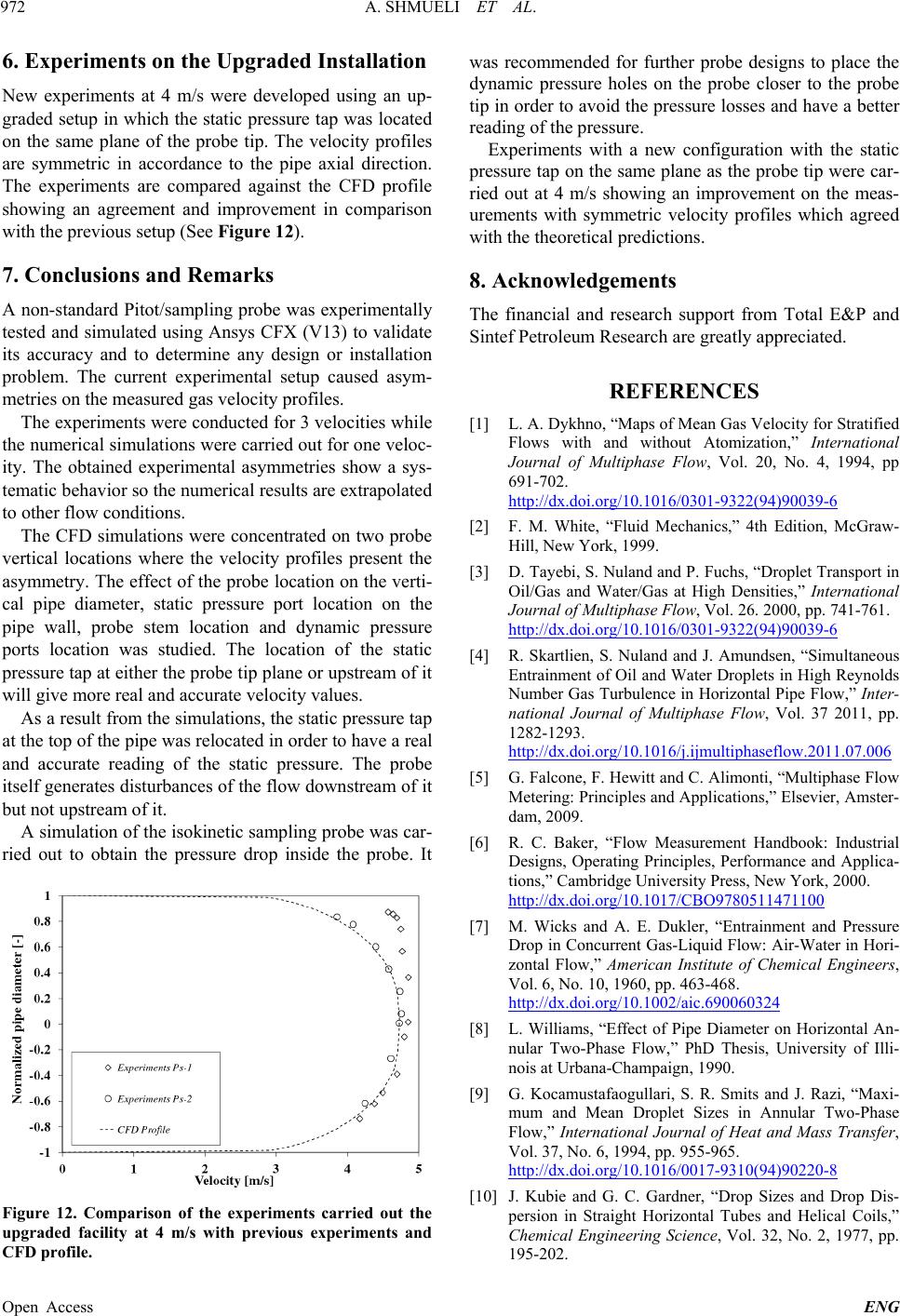
A. SHMUELI ET AL.
972
6. Experiments on the Upgraded Installation
New experiments at 4 m/s were developed using an up-
graded setup in which the static pressure tap was located
on the same plane of the probe tip. The velocity profiles
are symmetric in accordance to the pipe axial direction.
The experiments are compared against the CFD profile
showing an agreement and improvement in comparison
with the previous setup (See Figure 12).
7. Conclusions and Remarks
A non-standard Pitot/sampling probe was experimentally
tested and simulated using Ansys CFX (V13) to validate
its accuracy and to determine any design or installation
problem. The current experimental setup caused asym-
metries on the measured gas velocity profiles.
The experiments were conducted for 3 velocities while
the numerical simulations were carried out for one veloc-
ity. The obtained experimental asymmetries show a sys-
tematic behavior so the numerical results are extrapolated
to other flow conditions.
The CFD simulations were concentrated on two probe
vertical locations where the velocity profiles present the
asymmetry. The effect of the probe location on the verti-
cal pipe diameter, static pressure port location on the
pipe wall, probe stem location and dynamic pressure
ports location was studied. The location of the static
pressure tap at either the probe tip plane or upstream of it
will give more real and accurate velocity values.
As a result from the simulations, the static pressure tap
at the top of the pipe was relocated in order to have a real
and accurate reading of the static pressure. The probe
itself generates disturbances of the flow downstream of it
but not upstream of it.
A simulation of the isokinetic sampling probe was car-
ried out to obtain the pressure drop inside the probe. It
Figure 12. Comparison of the experiments carried out the
upgraded facility at 4 m/s with previous experiments and
CFD profile.
was recommended for further probe designs to place the
dynamic pressure holes on the probe closer to the probe
tip in order to avoid the pressure losses and have a better
reading of the pressure.
Experiments with a new configuration with the static
pressure tap on the same plane as the probe tip were car-
ried out at 4 m/s showing an improvement on the meas-
urements with symmetric velocity profiles which agreed
with the theoretical predictions.
8. Acknowledgements
The financial and research support from Total E&P and
Sintef Petroleum Research are greatly appreciated.
REFERENCES
[1] L. A. Dykhno, “Maps of Mean Gas Velocity for Stratified
Flows with and without Atomization,” International
Journal of Multiphase Flow, Vol. 20, No. 4, 1994, pp
691-702.
http://dx.doi.org/10.1016/0301-9322(94)90039-6
[2] F. M. White, “Fluid Mechanics,” 4th Edition, McGraw-
Hill, New York, 1999.
[3] D. Tayebi, S. Nuland and P. Fuchs, “Droplet Transport in
Oil/Gas and Water/Gas at High Densities,” International
Journal of Multiphase Flow, Vol. 26. 2000, pp. 741-761.
http://dx.doi.org/10.1016/0301-9322(94)90039-6
[4] R. Skartlien, S. Nuland and J. Amundsen, “Simultaneous
Entrainment of Oil and Water Droplets in High Reynolds
Number Gas Turbulence in Horizontal Pipe Flow,” Inter-
national Journal of Multiphase Flow, Vol. 37 2011, pp.
1282-1293.
http://dx.doi.org/10.1016/j.ijmultiphaseflow.2011.07.006
[5] G. Falcone, F. Hewitt and C. Alimonti, “Multiphase Flow
Metering: Principles and Applications,” Elsevier, Amster-
dam, 2009.
[6] R. C. Baker, “Flow Measurement Handbook: Industrial
Designs, Operating Principles, Performance and Applica-
tions,” Cambridge University Press, New York, 2000.
http://dx.doi.org/10.1017/CBO9780511471100
[7] M. Wicks and A. E. Dukler, “Entrainment and Pressure
Drop in Concurrent Gas-Liquid Flow: Air-Water in Hori-
zontal Flow,” American Institute of Chemical Engineers,
Vol. 6, No. 10, 1960, pp. 463-468.
http://dx.doi.org/10.1002/aic.690060324
[8] L. Williams, “Effect of Pipe Diameter on Horizontal An-
nular Two-Phase Flow,” PhD Thesis, University of Illi-
nois at Urbana-Champaign, 1990.
[9] G. Kocamustafaogullari, S. R. Smits and J. Razi, “Maxi-
mum and Mean Droplet Sizes in Annular Two-Phase
Flow,” International Journal of Heat and Mass Transfer,
Vol. 37, No. 6, 1994, pp. 955-965.
http://dx.doi.org/10.1016/0017-9310(94)90220-8
[10] J. Kubie and G. C. Gardner, “Drop Sizes and Drop Dis-
persion in Straight Horizontal Tubes and Helical Coils,”
Chemical Engineering Science, Vol. 32, No. 2, 1977, pp.
195-202.
Open Access ENG